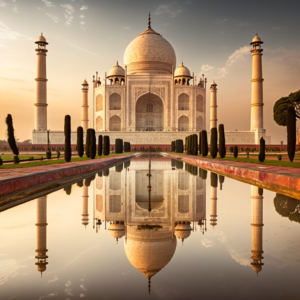
Asia is home to some of the world’s most awe-inspiring destinations. From ancient religious sites to stunning natural wonders, there’s no shortage of incredible places to explore. Whether you’re looking for history, culture, or stunning scenery, the following 5 must-see destinations in Asia will leave you breathless. From the majestic Angkor Wat temple complex of Cambodia to the breathtaking Taj Mahal in India, get ready to be inspired by some of the most beautiful places in the world.
Angkor Wat, Cambodia
Angkor Wat is a must-see destination in Asia. Located in Cambodia, this ancient temple complex is a stunning example of Khmer architecture and is the largest religious monument in the world. Built in the early 12th century, Angkor Wat is considered a remarkable achievement in design, engineering, and art. Visiting Angkor Wat is an unforgettable experience. Here are the top ten benefits of visiting this incredible destination:
- Admire the history and culture: Angkor Wat was the capital of the ancient Khmer Empire, and the ruins are a testament to the sophistication of the people who lived there.
- Explore the temples: Angkor Wat is home to more than 100 temples, many of which are still standing today.
- Spot wildlife: Angkor Wat is home to a variety of wildlife such as monkeys, elephants, and birds. Climb the towers: Climb the towers of Angkor Wat to get a breathtaking view of the complex and the surrounding area.
- Enjoy the sunsets: The sunsets at Angkor Wat are truly breathtaking, and the perfect way to end a day of exploration.
Taj Mahal, India
The Taj Mahal is an iconic symbol of India and one of the most beautiful and recognizable monuments in the world. Located in Agra, India, the Taj Mahal is an ivory-white marble mausoleum built by Mughal emperor Shah Jahan in memory of his beloved wife Mumtaz Mahal. Completed in 1653, the Taj Mahal is a stunning example of Mughal architecture, combining elements of Persian, Indian, and Islamic styles. The Taj Mahal is a UNESCO World Heritage Site and one of the seven wonders of the world.
Great Wall of China
The Great Wall was constructed as a defensive measure to protect the Chinese Empire from invaders. It was constructed in various phases, beginning in the 7th century BC and lasting until the 17th century AD. It is the longest wall in the world and still stands today as a testament to the engineering and craftsmanship of the Chinese. The exact length of the Great Wall of China is unknown, but it is estimated to be over 21,000 km (13,000 mi) long.
Visitors to the Great Wall can explore the various sections, including the Badaling, Mutianyu, and Jinshanling sections. Tourists can
- climb up the steep pathways
- explore the watchtowers
- take in the stunning views from the top
For those who want a unique experience, there are also cable cars and toboggan rides available. To experience the grandeur of the Great Wall for yourself, find the best deals for travel to China.
Forbidden City, Beijing
The Forbidden City in Beijing, China is one of Asia’s most iconic tourist attractions. This 15th century palace complex was once the home of the Chinese emperors and their families. Tourists visiting the Forbidden City will be able to explore some of the best-preserved imperial architecture in the world. There are numerous benefits to visiting the Forbidden City, including:
- Impressive architecture: The Forbidden City is an incredible example of imperial Chinese architecture. The palace complex is composed of 980 buildings, including the Hall of Supreme Harmony, the Hall of Central Harmony, and the Hall of Preserving Harmony.
- Rich history: The Forbidden City is steeped in over 500 years of history. As you walk through the palace complex, you can learn about the lives of the Chinese emperors and their families.
- Beautiful gardens: The Forbidden City is home to several beautiful gardens, including the Imperial Garden and the Garden of Compassion and Tranquility. The gardens feature a variety of flowers and trees, making them a peaceful oasis in the heart of Beijing.
- Fascinating artifacts: Visitors to the Forbidden City can explore an impressive collection of artifacts, including ancient pottery, jade, and bronze sculptures.
Petronas Twin Towers, Malaysia
The Petronas Twin Towers are an iconic symbol of Malaysia’s bustling metropolis, Kuala Lumpur. The 88-floor twin towers stand tall at a height of 451.9 meters and feature a magnificent steel and glass facade designed by renowned architect Cesar Pelli. The towers are connected by a sky bridge at the 41st and 42nd floors, offering stunning views of the city below.
The towers are the home to the multinational oil and gas company, Petronas, and also feature a shopping mall, a science center and an aquarium. Visitors can take a tour of the towers and enjoy the views from the sky bridge as well as explore the many shops and restaurants in the mall. You can also learn more about Asian cuisine.
Asia is an incredible continent with something to offer everyone. From the bustling cities of Tokyo and Hong Kong to the tranquil beauty of the Taj Mahal and the Great Wall of China, there is something for everyone. Whether you’re looking for a cultural adventure, a relaxing beach getaway, or an adrenaline-fueled expedition, Asia has something to offer. With its diverse range of cultures, languages, and landscapes, there is something for everyone in this amazing continent. So, if you’re planning a trip to Asia, be sure to check out these five must-see destinations.
Located in Cambodia, this ancient temple complex is a stunning example of Khmer architecture and is the largest religious monument in the world. Built in the early 12th century, Angkor Wat is considered a remarkable achievement in design, engineering, and art.
Located in Agra, India, the Taj Mahal is an ivory-white marble mausoleum built by Mughal emperor Shah Jahan in memory of his beloved wife Mumtaz Mahal.
The exact length of the Great Wall of China is unknown, but it is estimated to be over 21,000 km (13,000 mi) long.
